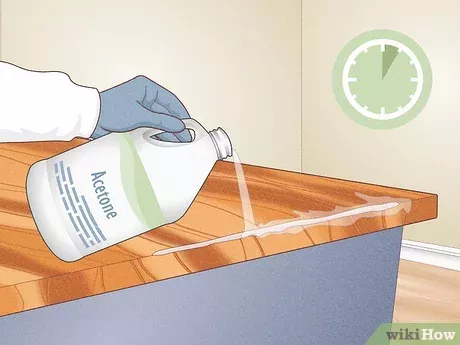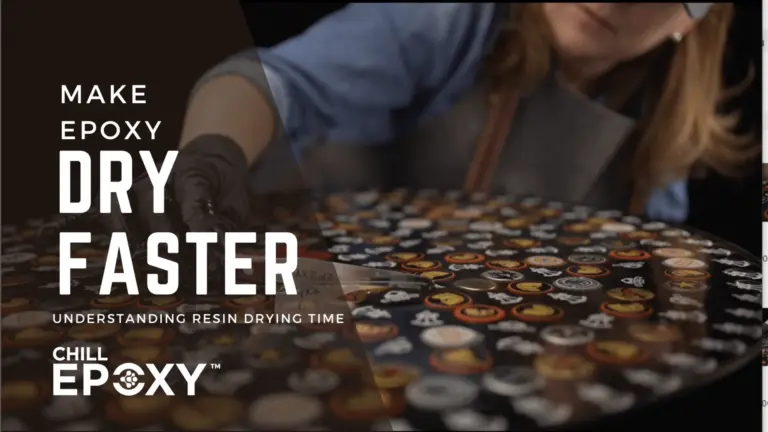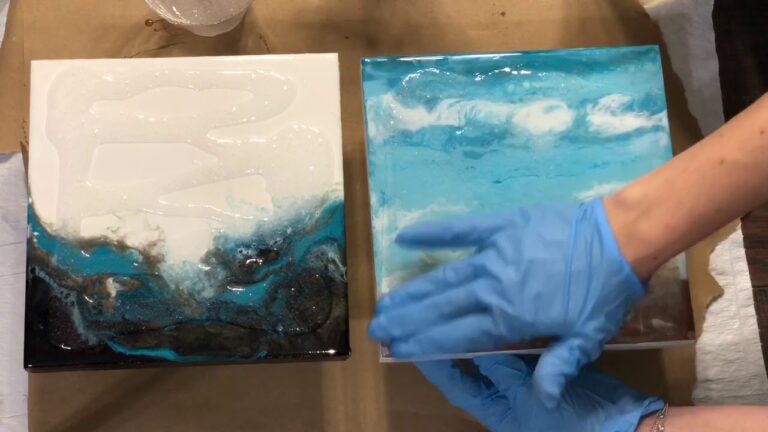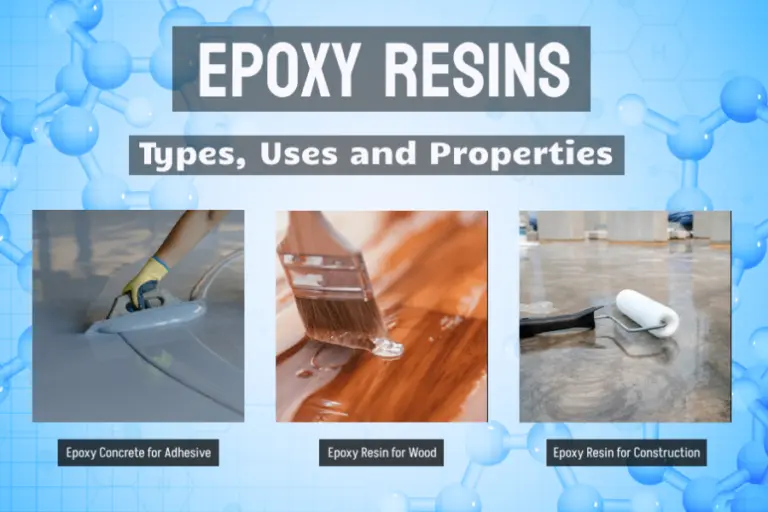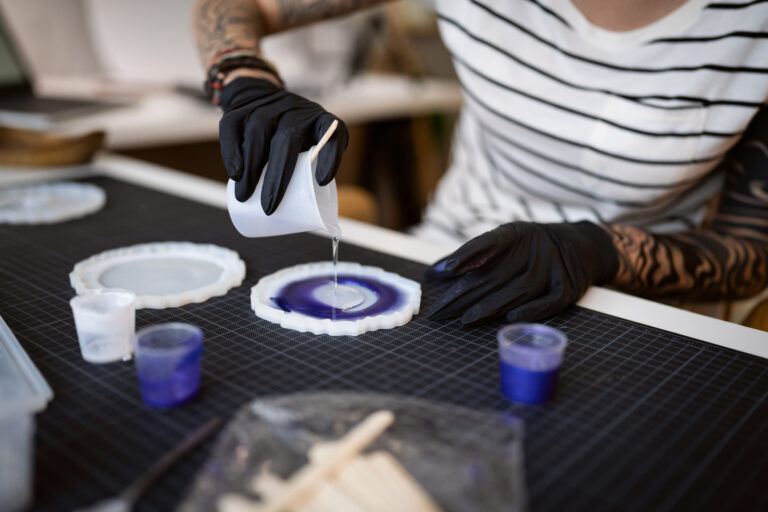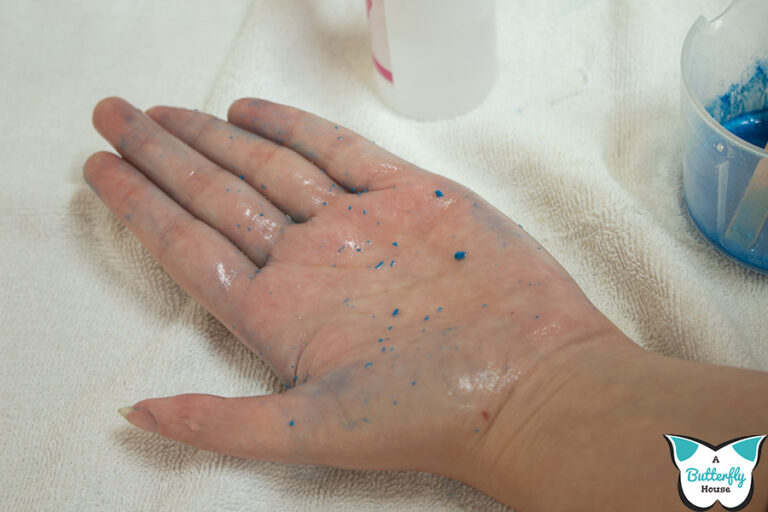How to Remove Epoxy Resin: Effective Methods
Removing Epoxy Resin
Removing epoxy resin can be tricky. Here are some effective methods to help you.
Softening Epoxy with Heat
Softening epoxy with heat makes it easier to scrape away. Heating the epoxy beyond its Tg (softening point) can help. Use a heat gun or hairdryer to apply heat in small sections (FOC Epoxy Resources). This repeated heating process will help penetrate the layers effectively.
| Tool | Temperature (°F) | Ease of Use |
|---|---|---|
| Heat Gun | 500 | High |
| Hairdryer | 140 | Medium |
Ensure you use a plastic scraper to avoid damaging the surface beneath the epoxy. For more tips, check our article on how to get epoxy resin off hands.
Utilizing Temperature Cycling
Temperature cycling involves alternating hot and cold temperatures to delaminate the epoxy bond. This method works well above the Tg and at colder temperatures to soften the epoxy for prying purposes.
You can use these cycles to create thermal shock:
- Step 1: Heat the epoxy area with a heat gun
- Step 2: Rapidly cool the area with ice packs
This repeated thermal cycling forces the bond line to weaken, facilitating easier removal. Make sure to use a plastic scraper for prying. For further information, check out our section on how to clean epoxy resin off tools.
Hot Water Method
The hot water method is a non-aggressive way to remove epoxy. Placing the epoxy-bonded part in hot (boiling) water for several hours can lead to the substrates falling apart without extensive prying (FOC Epoxy Resources).
| Water Temperature (°F) | Time Required |
|---|---|
| Boiling (212) | 3-4 hours |
| Hot Tap Water (120) | 6-8 hours |
After soaking, the epoxy should have softened enough to be pried away easily. This method is especially helpful when dealing with delicate items. Check out our guide on how to use epoxy resin on wood for more practical information.
By using the methods above, you can effectively manage the removal of epoxy resin without causing extensive damage to the underlying surfaces. For more detailed insights on epoxy, explore our articles on what is epoxy resin and how to remove epoxy resin from metal.
Chemical Solutions for Epoxy Removal
Chemical solutions can be effective for removing epoxy resin. Below are methods using different chemicals to help you get rid of unwanted epoxy.
Using Acetone and Solvents
Using acetone and various solvents is a widely accepted method for epoxy removal. Acetone is readily available and can soften epoxy resin, making it easier to scrape off. For stubborn or extensive epoxy layers, more aggressive solvents may be required. Always test the solvent on a small, inconspicuous area to ensure it does not damage the underlying substrate.
Process:
- Soak a cloth in acetone.
- Apply it to the epoxy-covered area.
- Let it sit for a few minutes to soften the epoxy.
- Scrape the softened epoxy off with a plastic scraper.
Note: Ensure good ventilation and wear gloves when using acetone or other solvents.
| Chemical | Effectiveness | Safety Precautions |
|---|---|---|
| Acetone | Moderate | Use gloves, ensure ventilation |
| Methylene Chloride | High | Use in well-ventilated area, wear protective gear |
| MEK (Methyl Ethyl Ketone) | High | Highly flammable, use with caution |
For more detailed information on cleaning epoxy from your tools, visit how to clean epoxy resin off tools.
Sulfuric Acid Technique
Sulfuric acid is a strong chemical that can break down hardened epoxy quickly and efficiently. This method does not require soaking but involves meticulous application.
Process:
- Apply a small amount of sulfuric acid directly onto the epoxy resin.
- Allow the acid to react with the resin for several minutes.
- Scrape off the epoxy using a tool suitable for the substrate.
Safety Note: This method should be used with extreme caution. Wear appropriate protective gear including gloves, goggles, and ensure adequate ventilation (EpoxyMan).
Isopropyl Alcohol Removal
Isopropyl alcohol (IPA) is another effective solvent for removing epoxy resin. It is particularly useful for delicate surfaces as it is less aggressive than other solvents.
Process:
- Saturate a cloth with isopropyl alcohol.
- Rub the epoxy-covered area gently.
- Allow it to sit for a few minutes if necessary to soften the resin.
- Wipe or scrape off the softened epoxy.
| Chemical | Effectiveness | Safety Precautions |
|---|---|---|
| Isopropyl Alcohol | Moderate | Use gloves, ensure ventilation |
| Dimethyl Adipate | High | Use with caution, protective gear advisable |
For environmentally friendly solutions and more tips on handling resin, explore how to remove epoxy resin from metal.
Find more advice on epoxy resin, such as how to clean epoxy resin off different surfaces and exploring what dissolves epoxy resin effectively.
Mechanical Methods for Epoxy Removal
When it comes to removing epoxy resin, using mechanical methods can be highly effective. These methods focus on physically manipulating the epoxy to facilitate its removal. Here are some effective techniques:
Prying for Epoxy Softening
One method to remove epoxy resin involves softening the epoxy by heating it beyond its glass transition temperature (Tg). This makes the epoxy more pliable and easier to scrape away. To do this, you can:
- Use a heat gun or blow dryer to heat specific sections of the epoxy.
- Once the epoxy is softened, use a plastic scraper to peel it away.
Pro tip: Heat small sections at a time to effectively penetrate layers of epoxy with repeated heating.
| Tool | Ideal Temperature Range for Softening Epoxy |
|---|---|
| Heat Gun | 120°F – 300°F |
| Hair Dryer | 120°F – 180°F |
| Plastic Scraper | Use to manually scrape softened epoxy |
For the best results, visit our guide on how to clean epoxy resin off tools.
Specialized Tools for Cleanup
Specialized tools are crucial when dealing with epoxy residue. After softening the epoxy, you may need to pry it off using tools like dental instruments or small hand drill bits. Here are some effective tools:
- Dental Instruments: For precision in scraping or prying.
- Hand Drill Bits: For drilling through thicker epoxy layers.
- Plastic Scrapers: To avoid damaging the underlying surface.
These tools facilitate detailed cleanup and ensure that the surface remains intact. Discover more about how to mix epoxy resin for future applications.
Heating Epoxy for Separation
Another method for easing epoxy removal is through direct heating. By warming the bond line with a heat gun or soldering iron, you can weaken the epoxy’s adhesive properties, making it easier to separate the bond.
- Use a heat gun or a soldering iron to apply heat directly to the epoxy bond line.
- The heat will weaken the bond, allowing you to pry the parts apart with less effort.
| Tool | Temperature |
|---|---|
| Heat Gun | 300°F – 500°F |
| Soldering Iron | 450°F – 750°F |
Check out our article on how to remove epoxy resin from metal for more tips.
For more comprehensive guidance, refer to our articles on how to use epoxy resin and is epoxy resin flammable.
Epoxy Flooring Removal
If you’re contemplating removing epoxy flooring, this section covers the benefits, methods, timeframes, and the significance of preparing the surface.
Benefits of Removing Epoxy Flooring
Removing epoxy flooring offers several advantages. First, it allows you to update the space’s appearance, addressing any damage or wear that has occurred over time (Paradigm Concrete Finishes). Second, it prepares the substrate for a new flooring system, ensuring optimal adhesion and longevity. Whether you’re opting for a fresh coat of epoxy or entirely new flooring, the removal process sets the stage for effective results.
Methods and Timeframes
The time required for epoxy flooring removal depends on the method used. Several options are available to you, each with varying time commitments and effectiveness.
| Method | Time Required |
|---|---|
| Solvent Method | Several hours to a few days |
| Sanding or Grinding | A few days to a week |
| Manual Removal by Hand | Several days to a few weeks |
Figures sourced from Paradigm Concrete Finishes
The solvent method is generally faster but requires proper ventilation due to chemical fumes. Sanding or grinding is more labor-intensive but can be suitable for removing thick epoxy coatings. Manual removal is the most time-consuming but doesn’t involve chemicals or machinery.
Surface Preparation Importance
Proper surface preparation is essential for the adhesion and longevity of your new flooring system. This involves a series of steps, including cleaning, etching, and patching the concrete substrate (Paradigm Concrete Finishes).
- Cleaning: Remove any dirt, grease, or debris from the surface to ensure the new coating adheres properly.
- Etching: Use an etching solution to roughen the concrete, creating a better bond for the new epoxy.
- Patching: Fill any holes or cracks in the concrete to create a smooth, even surface.
For more detailed steps on preparing your surface and other related aspects of epoxy use, visit our articles on how to clean epoxy resin, how to cure epoxy resin, and how to mix epoxy resin.
Understanding these aspects will help ensure your next flooring project is successful and long-lasting. Whether you choose to use solvents, sanding, or manual tools, having a clear plan and knowing the time it will take can make this task manageable and efficient.
Removing Epoxy Resin Uncured
Uncured epoxy resin can be a sticky problem, but fortunately, there are effective methods for cleaning it up. In this section, we’ll explore how you can use specialized products and eco-friendly solutions to remove uncured epoxy resin effectively.
Alumilite Resin Remover
The Alumilite Amazing Resin Remover is specifically designed for handling uncured epoxy resin messes. It’s a fast and safe solution for cleaning spills, smudges, and mishaps during your crafting process.
To remove uncured resin, follow these steps:
- Apply a few drops of Alumilite Amazing Resin Remover to the affected area.
- Gently rub the remover into the resin.
- Wipe away the residue with a cloth.
- Rinse the area with soapy water.
This method effectively cleans uncured resin off various surfaces such as work tables, tools, mixing containers, and even clothing.
Effective Uncured Resin Removal
Besides using specialized removers like Alumilite, there are basic practices you can follow to ensure effective uncured resin removal:
- Act Quickly: The sooner you address the spill, the easier it is to clean up.
- Use the Right Tools: Soft cloths and mild soapy water can help in wiping away the residue.
- Test a Small Area First: Especially when dealing with delicate surfaces, test the remover in an inconspicuous spot.
Benefits of Using Alumilite Amazing Resin Remover:
- Designed for uncured epoxy
- Gentle on multiple surfaces
- Easy-to-use application
For more detail on proper techniques, check out our guide on how to clean epoxy resin.
Eco-Friendly Solution
If you’re environmentally conscious, the Alumilite Amazing Resin Remover is a green alternative to harsh chemical-based cleaners. It offers a sustainable approach to resin cleanup, ensuring your efforts are kind to the planet.
| Feature | Alumilite Amazing Resin Remover |
|---|---|
| Primary Use | Uncured Epoxy Resin |
| Application | Drops and Rub |
| Surfaces | Work Tables, Tools, Clothing, Containers |
| Eco-Friendly | Yes |
| Harsh Chemicals | None |
Users have shared testimonials attesting to its effectiveness and the satisfaction they have found in avoiding chemical-heavy solutions.
By utilizing these methods and products, you ensure that your crafting remains clean and environmentally friendly. For more tips on epoxy resin, visit our articles on how to mix epoxy resin and is epoxy resin toxic.
Environmental Impact of Plastic Waste
Understanding the environmental impact of plastic waste is essential, especially when dealing with adhesives like epoxy resin. Here, we focus on the broader scope of plastic waste pollution, its effects on the marine environment, and how the COVID-19 pandemic has exacerbated the issue with single-use plastics.
Plastic Waste Pollution
Plastic waste comprises about 10-13% of the total inorganic content in municipal solid waste (PubMed Central). This waste includes plastic bottles, bags, containers, cups, packaging materials, and more. The pervasive nature of plastic waste poses severe threats to living beings, impacting both terrestrial and marine environments.
| Waste Source | Contribution to Pollution (%) |
|---|---|
| Bottles and Containers | 35 |
| Packaging Materials | 25 |
| Bags and Accessories | 20 |
| Miscellaneous | 20 |
Plastic waste management requires extensive research to develop effective strategies that mitigate environmental impacts. For further details on related topics, you can read about how to clean epoxy resin off tools.
Microplastics in Marine Environment
An estimated 51 trillion microplastics float in the sea (PubMed Central). These tiny plastic particles come from sources like synthetic textiles, car tires, city dust, and personal care products. These microplastics eventually make their way into the food chain, affecting marine animals and humans who consume seafood.
| Source of Microplastics | Percentage Contribution |
|---|---|
| Synthetic Textiles | 35 |
| Car Tires | 28 |
| City Dust | 24 |
| Road Markings | 9 |
| Personal Care Products | 4 |
Approximately 80% of marine debris originates from land sources, such as rivers in Southeast Asia, which contributes significantly to marine pollution (PubMed Central). Coastal populations in the Northern Hemisphere also significantly affect the accumulation of plastics in oceanic gyres and basins.
Single-Use Plastics During COVID-19
The COVID-19 pandemic has led to an unprecedented rise in single-use plastics, such as protective hospital suits, gloves, face masks, and hand sanitizer bottles. This surge has contributed millions of plastic items to the environment, exacerbating the issue of microplastics in agricultural soil and rivers (PubMed Central).
| Single-Use Plastic Items | Environmental Impact |
|---|---|
| Face Masks | High |
| Gloves | High |
| Protective Suits | Medium |
| Hand Sanitizer Bottles | Medium |
The increased consumption of single-use plastics during the pandemic raises significant environmental risks, highlighting the need for more sustainable practices. For related topics on adhesives, check out how to remove epoxy resin from metal and how to use epoxy resin.
Understanding these aspects of plastic waste can help you make informed decisions about how to remove epoxy resin effectively and responsibly.

